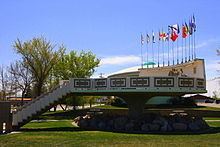Country Canada Census division 12 Time zone MST (UTC−7) Population 5,827 (2016) | Founded 1896 Elevation 645 m Local time Friday 11:00 PM Team St. Paul Canadiens | |
 | ||
Weather 0°C, Wind E at 18 km/h, 83% Humidity Area codes Area code 780, Area codes 587 and 825 | ||
Wave of violence in st paul alberta
St. Paul, originally known as St-Paul-de-Métis or St-Paul-des-Métis, is a town in east-central Alberta, Canada, within the County of St. Paul No. 19. It was known as St. Paul de(s) Métis between 1912 and 1936.
Contents
- Wave of violence in st paul alberta
- Map of St Paul AB Canada
- History
- Demographics
- Economy
- Attractions
- Notable people
- References
Map of St. Paul, AB, Canada
History
The community was founded as a Métis colony in 1896, but the colony later dissolved sometime between 1905 and 1909. After the area was made available to other groups in 1909, primarily the French-Catholic, the community incorporated as the Village of St. Paul de Métis on June 14, 1912, though it was referred to as St. Paul des Métis by June 6, 1922. It then incorporated as the Town of St. Paul on December 15, 1936.
Demographics
In the 2016 Census of Population conducted by Statistics Canada, the Town of St. Paul recorded a population of 5,827 living in 2,248 of its 2,378 total private dwellings, a 7000780000000000000♠7.8% change from its 2011 population of 5,405. With a land area of 8.64 km2 (3.34 sq mi), it had a population density of 674.4/km2 (1,746.7/sq mi) in 2016.
The population of the Town of St. Paul according to its 2014 municipal census is 6,004, a 7000270000000000000♠2.7% change from its 2012 municipal census population of 5,844.
In the 2011 Census, the Town of St. Paul had a population of 5,400 living in 2,169 of its 2,338 total dwellings, a 5.8% change from its 2006 population of 5,106. With a land area of 7.89 km2 (3.05 sq mi), it had a population density of 684.4/km2 (1,772.6/sq mi) in 2011. In 2012, Statistics Canada adjusted St. Paul's 2011 population by an additional 5 people to 5,405 to reflect its 2011 annexation.
Economy
St. Paul's economy is driven by the agriculture and service industries. St. Paul is located in Alberta's Lakeland tourism district.
Attractions
St. Paul is home to the world's first UFO landing pad, built as a centennial project in an effort to attract both tourists and Martians to the municipality. The pad consists of a raised platform with a map of Canada embossed on the back stop, consisting of stones provided by each province of Canada.
On June 3, 1967, Paul Hellyer, Minister of National Defence, flew in by helicopter to officially open the Pad. The pad was one of over 100 Centennial Projects organized by the town.
The sign beside the pad reads: "The area under the World's First UFO Landing Pad was designated international by the Town of St. Paul as a symbol of our faith that mankind will maintain the outer universe free from national wars and strife. That future travel in space will be safe for all intergalactic beings, all visitors from earth or otherwise are welcome to this territory and to the Town of St. Paul."
The UFO Landing pad was also featured across Canada as a film crew with Cineplex Entertainment was in the town in May 2014 filming a pre-show piece to be played in Cineplex movie theatres across Canada throughout the month of June.
